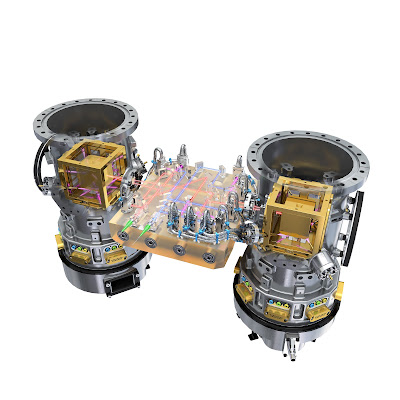The following link gives an overview on the experiment that yielded the detection, LIGO
The press conference with illustrating material is given here
More background material can be found here at NATURE
And in a NATURE Special
There is an ESA space mission currently working as well: LISA Pathfinder
As the name might imply, this is a test of technical feasability for a much larger experiment that is in preparation.
Here are some updates: the dections were made 7 milliseconds apart NATURE
The LISA Pathfinder continues
Spacetime Curvature
More measuring Spacetime curvature
Here is LISA Pathfinder’s journey to L1
And how it will work.
Inside LISA Pathfinder, with narration
By the way this location is also where SOHO observes the sun
Sky and Telescope
has illustrations as well as links to yesterday's event. It also ran a cover story in December 2015:
Gravitational Waves Hit Prime Time
Kip Thorne's interview
The Scout Report has a compilation of reports which I have simply cut and pasted below along with their copyright notice. I have been subscribing to Scout Report for the past 22 years.
18. After 100 Years of Searching, Scientists Detect Gravitational Waves
Einstein's gravitational waves found at last
http://www.nature.com/news/einstein-s-gravitational-waves-found-at-last-1.19361
Gravitational waves, Einstein's ripples in spacetime, spotted for first
time
http://www.sciencemag.org/news/2016/02/gravitational-waves-einstein-s-ripples-spacetime-spotted-first-time
Gravitational Waves Exist: The Inside Story of How Scientists Finally Found
Them
http://www.newyorker.com/tech/elements/gravitational-waves-exist-heres-how-scientists-finally-found-them
Observation of Gravitational Waves from a Binary Black Hole Merger
https://journals.aps.org/prl/abstract/10.1103/PhysRevLett.116.061102
LIGO Caltech: What are Gravitational Waves?
https://www.ligo.caltech.edu/page/what-are-gw
Futurism: How Gravitational Waves Work (infographic)
http://futurism.com/the-physics-of-gravitational-waves-heres-how-they-work-infographic/
In a highly anticipated announcement this week, physicists with the Laser
Interferometer Gravitational-Wave Observatory (LIGO) confirmed the
existence of gravitational waves - or ripples in the fabric of spacetime.
The team of scientists revealed how on September 14, 2015, twin detectors
observed the gravitational 'ringing' produced by the collision of two black
holes a billion light years away. The scientists listened for 20
thousandths of a second as the two giant black holes, one 35 times the mass
of the sun, the other slightly smaller, circled around each other. As they
finally merged, a tremendous burst of energy was released, propagating
through space as gravitational waves. Shortly after the September event,
LIGO recorded another, weaker signal that was probably also from black
holes, the team said. As noted by physicist Stephen Hawking of the
University of Cambridge, UK, "These amazing observations are the
confirmation of a lot of theoretical work, including Einstein's general
theory of relativity, which predicts the gravitational waves." This
historic discovery is sure to usher in an entirely new way of studying the
universe, including the new field of gravitational wave astronomy in which
scientists will listen to the waves to learn more about the objects that
can produce them. [CBD]
<i>Nature</i> and <i>Science</i> reported this week on the historical
discovery, offering readers in depth articles on the detection of
gravitational waves. Both are noteworthy, but the <i>Science</i> article
stands out for its visuals, media clips, and helpful timeline that traces
the search for gravitational waves, from prediction to reality. Next,
Nicola Twilley of <i>The New Yorker</i> skillfully narrates the "inside
story" of how scientists finally found gravitational waves in the third
resource, while readers specifically interested in the physics behind the
discovery will find an academic article released earlier this week by the
American Physical Society (APS) to be of interest. Readers curious about
what exactly gravitational waves are will enjoy this next resource from
LIGO. Finally, Futurism introduces the physics behind gravitational waves
via two compelling infographics. Originally published by space.com and
Nature, these visual aids detail how gravitational waves work, why they are
important, and how we might detect them.
Below are the copyright statements to be included when reproducing
annotations from The Scout Report.
The single phrase below is the copyright notice to be used when
reproducing any portion of this report, in any format:
From The Scout Report, Copyright Internet Scout 1994-2016.
https://www.scout.wisc.edu
The paragraph below is the copyright notice to be used when
reproducing the entire report, in any format:
Copyright (c) 2016 Internet Scout Research Group - https://scout.wisc.edu
The Internet Scout Research Group, located in the Computer Sciences
Department at the University of Wisconsin-Madison, provides Internet
publications and software to the research and education communities
under grants from the National Science Foundation, the Andrew W.
Mellon Foundation, and other philanthropic organizations. Users may make
and
distribute verbatim copies of any of Internet Scout's publications or
web content, provided this paragraph, including the above copyright
notice, is preserved on all copies.
Any opinions, findings, and conclusions or recommendations expressed
in this publication are those of the author(s) and do not necessarily
reflect the views of the University of Wisconsin-Madison, or the
National Science Foundation.




No comments:
Post a Comment